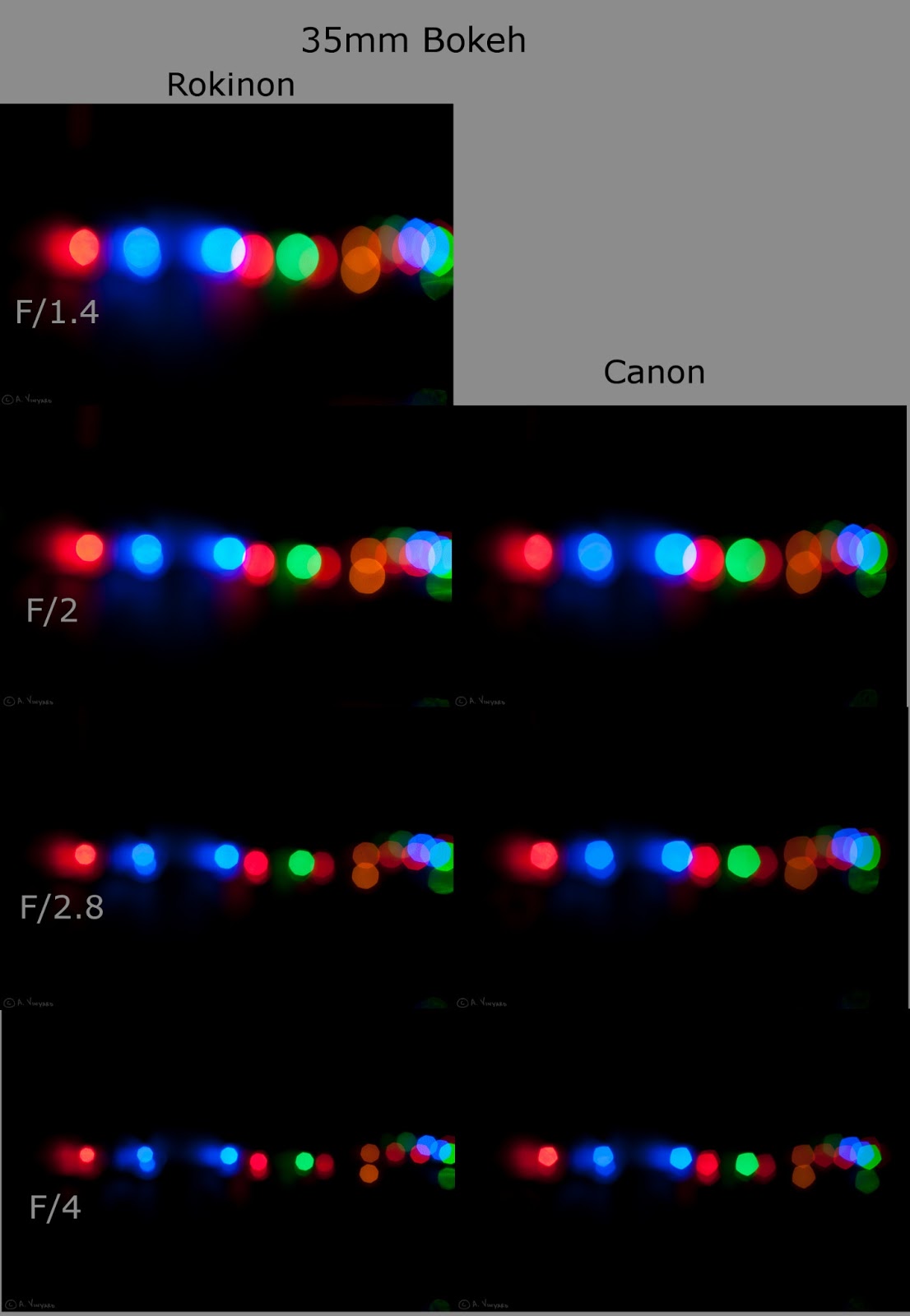 | |
| David vs. Goliath |
I recently purchased the Rokinon(Samyang) 35mm f/1.4 UMC when I saw a deal for it online that I couldn't refuse. $369 from Buydig.com. It's list price is $499, though you can usually get it a little cheaper than that. Here's what you should know about it. It's plastic, but solid and well made. It is manual focus only. It's huge, by far the largest lens I own. It has a f/1.4 aperture.
In the other corner we have the canon 35mm f/2. I've had this one for a while, and I use it a lot on my T2i. It cost me $285 used and could be bought new for about $329 until it was recently discontinued. It's replacement costs a paltry $849 with improved optical performance and image stabilization. The original is a fantastic almost normal lens on a crop sensor camera. Here's what you should know. It's plastic, light and compact. It has autofocus and an F/2 aperture.
Both lenses are way cheaper than you're other native mount options. The fantastic new Sigma 35 f/1.4 will cost you about $899, the Canon 35mm L will run you a little over $1300, and the Canon 16-35mm f/2.8 L II zoom might break the bank at $1499. There's also the 35mm f/2 IS USM that I mentioned before. (Bear in mind that these are prices from the time of post.)
Here's a couple more pictures:
 |
| "My front element is bigger than yours!" -Rokinon |
 |
| "You've got a big ol' badonkadonk!" Canon |
First up are the resolution tests. These are not as scientifically done as they should be, obviously in places, so they shouldn't be taken as absolute. They do generally show the differences. I taped some Air Force 1957 optical charts in the center, at the top, and in the upper left hand corner of a crappy painting I painted. I then shot photos at varying apertures, with the painting completely filling the frame(I didn't line everything up perfectly, as you will see.) Oh, and this was done with my T2i using live view focusing, so this is representative of an APSC sensor. Corners will be even worse on a full frame. My 5D doesn't do like view. That's why I didn't use it,. Before I show you the pictures, I want to let you know the first difference. The Rokinon has a slightly longer focal length than the Canon. I had to move the tripod back a bit.
You can see that the canon's fairly sharp in the center and loses sharpness towards the edge and corners at all apertures. It vignettes pretty heavily and has some pretty intense purple fringing at wide apertures.
The Rokinon is pretty weak at f/1.4, but certainly sharpens up nicely. There is much less loss of sharpness toward the corners. It also seems to have less purple fringing.
Here are the comparison photos:
The Canon looks like it might be a little sharper at f/2 than the Rokinon, but it has way more purple fringing. They both sharpen up nicely by f/2.8. It looks like they both are starting to lose a little sharpness by f/8.
The Rokinon wins hands down here. The canon doesn't ever catch up.
Once again the Rokinon wins and the Canon never catches up. The Canon also appears to vignette more prominently.
Now sharpness isn't everything. How 'bout them bokeh balls? These were shot on the full frame 5D, hand held. Once again, not scientific.
I think they are both pretty decent. They both cat's eye a bit wide open. You can see a little bit of spirally funky texture on the Rokinon, but it's pretty subtle. The Canon is pretty smooth across the range. Octagons vs. Pentagons. I think octagons win, but it's not a huge win.
Following are some more bokeh comparisons from the backyard during the day. Everyone says the canon has nasty bokeh when it comes to busy backgrounds.
Rokinon f/1.4:
Canon f/2:
Rokinon f/2:
Canon f/2.8:
Rokinon f/2.8:
Canon f/4:
Rokinon f/4:
I think the Rokinon might have the edge here, especially when stopped down. Neither are stellar though, and I think they both look better wide open. Obviously the exposures aren't perfectly matched. The two lenses meter a bit differently on the 5D.
Here is busy background when focusing on an up close object. Exposed for the background, so the tiki torch is blown out. That's what happens when you shoot during the day. I wanted you to see the background.
Rokinon f/1.4:
Canon f/2:
Rokinon f/2:
Canon f/2.8:
Rokinon f/2.8:
Canon f/4:
Well, I don't know. Neither are great, but I've seen far worse. The Canon does seem to be a little warmer, though.
I guess the proof is the the pudding though. In regular use, it's obvious to me that the Rokinon is the better lens. It just sharper, and in real world use, the bokeh feels creamier. It just seems to be a smoother lens. Check out the following photos and decide for yourself. Both are a good alternative to the more expensive options. The Rokinon is pretty amazing for the price, if you can handle the manual focus. The canon is a perfect small normal lens for my T2i.
These pictures are all shot on the 5D at iso 400. Aperture and shutterspeed vary.
Canon:
Rokinon:


























